| ‘ J-PARC News - June 2017 (Issue #146) |
| Electron: Rotation wobble will cause irregularity in the Orbital - Correlation between electron spin wobble and electron orbital was revealed- (June 19, press release) |
|---|
| Takahisa Arima, professor of The University of Tokyo, and Ryoichi Kajimoto of the Neutron Science Section had worked jointly as a team to measure the wobble of electron spin (rotation) in compound oxides of manganese and vanadium which show magnetism utilizing a neutron beam derived from the 4d Space Access Neutron Spectrometer (4SEASONS) "SHIKI" (BL01) of Material and Science Experimental Facility (MLF); revealed that wobble of electron spin correlates with irregularity of electron orbital. Generally, atomic vibration or electric current is considered to conduct energy in solid substances. For magnetized solid substances, electron spin will be the key indicator in controlling heat conduction, magnetic field direction, and magnetic field intensity. It is expected that the knowledge obtained from this research will be utilized in developing innovative technology of thermal energy conduction in the future. The results of this research were published in the specialized magazine "Physical Review Letters" (June 30 online). |
| |
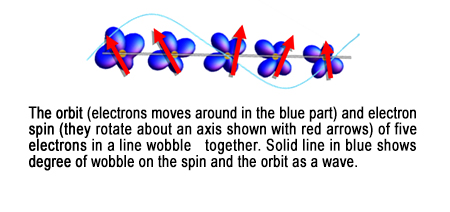
 * Click here to enlarge. * Click here to enlarge. |
| £to Page Top |
| |
|
| Mr. Ikuji Ikeda, president and CEO of Sumitomo Rubber Industries, LTD, visited J-PARC (June 12, J-PARC) |
|---|
| Mr. Ikuji Ikeda, president and CEO of Sumitomo Rubber Industries, LTD, visited J-PARC to tour MFL and the Neutrino Experimental Facility, exchanged views with Naoto Saito, Director of J-PARC. Sumitomo Rubber Industries established new materials development technology gADVANCED 4D NANO DESIGNh utilizing J-PARC and newly commercialized high fuel-efficient tires in 2016 which improved abrasion resistance by 51% compared with the existing products while maintaining a high level of fuel-efficiency plus high gripping performance. It has also shown that neutron technology will lead to successful results. The company will continue their research and development for technology utilizing J-PARC. |
| |
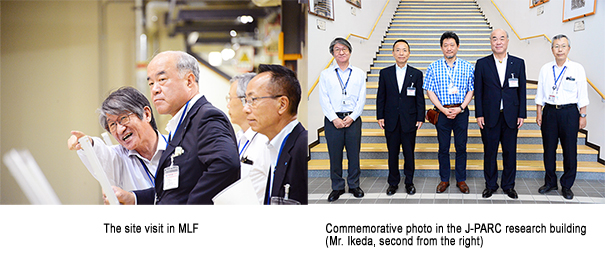
 * Click here to enlarge. * Click here to enlarge. |
| |
| £to Page Top |
| |
|
| Research Collaboration Meeting between SNS and J-PARC on spallation neutron source (June 6-9, J-PARC research building etc.) |
|---|
| A Research Collaboration Meeting between related parties from Neutron Source Facility at MLF of J-PARC and Oak Ridge National Laboratory Spallation Neutron Source (SNS) in the U.S. was held. SNS and J-PARC have many similarities in their equipments and structures of their facilities, such as utilizing mercury as a target material for neutron generating and cryogenic hydrogen as moderating material for MW(megawatt) neutron source. In this meeting, there were exchanges of information including views regarding development of high power neutron source technology in both facilities, also common issues and future cooperation between both parties were discussed on judging material fatigue caused by 10 years of operation, welding and grafting technology as well as technology for controlling damage caused by pressure wave. |
| |
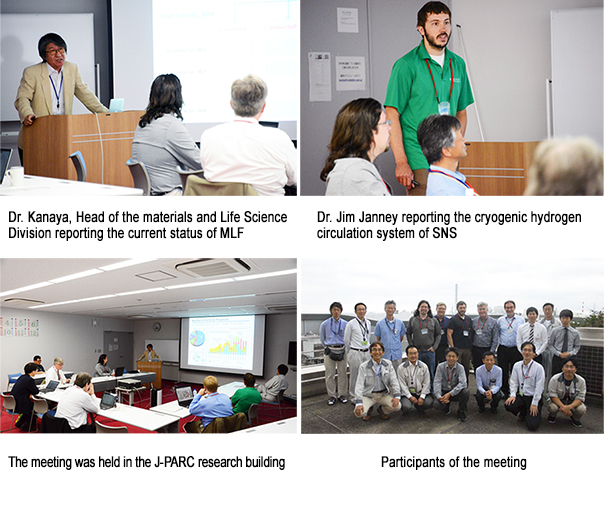
 * Click here to enlarge. * Click here to enlarge. |
| |
| £to Page Top |
| |
|
| Success in its first acceptance of neutron beam by POLANO spectrometer (June 9, J-PARC) |
|---|
| Construction of polarized neutron scattering equipment "POLANO" at MLF neutron beam line has progressed, and its first acceptance of the neutron beam was successful. POLANO is a beam line which is facilitated jointly by High Energy Accelerator Research Organization (KEK) and Tohoku University to be utilized for experiments to analyze vibrations of atoms and molecules which consist of solid substances or spin momentum using spin-polarized neutrons. Initially, performance verification tests on equipment using an unpolarized beam will be conducted. |
| |
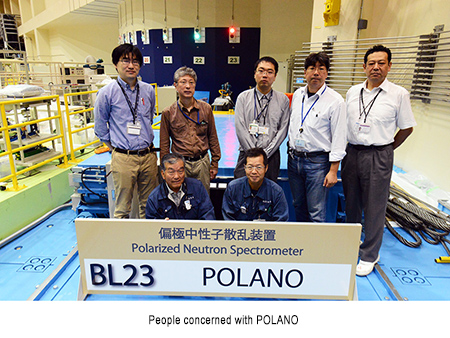
 * Click here to enlarge. * Click here to enlarge. |
| |
| £to Page Top |
| |
|
| Inspection of the Hadron Experimental Facility was implemented (May 31, J-PARC) |
|---|
| Facility inspection on application for changes in accordance with the Radiation Hazard Prevention Act was carried out on May 31 at Hadron Experimental Facility. Document screening, on site validation of shielding and radiation dosimetry test were implemented by the registered organization. As the notification of acceptance was given on June 2, Hadron Experimental Facility started its operation with a capacity of 37.5 kW beam outputs in the evening of the same day. |
| |
| £to Page Top |
| |
|
| Ibaraki University "KEK Day - Tour of Quantum Beam Science by Most Advanced Accelerator - " (June 7, J-PARC) |
|---|
| KEK and Ibaraki University jointly organized a facility tour for students from Ibaraki University's faculty of engineering to KEK's Accelerator facility. 34 participants visited J-PARC. Ibaraki University has established a new department "Institute of Quantum Beam Science" in its Graduate School of Science and Engineering in April 2016, which aims to develop human resources with the ability to utilize quantum beams in their research. KEK cooperates in the effort to enhance the university's functions on the development of human capital in accelerator science related areas. Ibaraki University also achieves successful results in study utilizing two neutron beam lines (iBIX and iMATERIA) which are located at MFL by Ibaraki prefecture as well as manages their operation and improves their performance. Participating students toured Linac, MLF, Hadron, and Neutrino Facilities after took part in the briefing session conducted by Dr. Shinichi Sakamoto from the PR section. Then they also visited the Accelerator Facility at KEK Tsukuba campus. Some students said "I could have a valuable experience." or "It motivated me to learn more for my future." |
| |
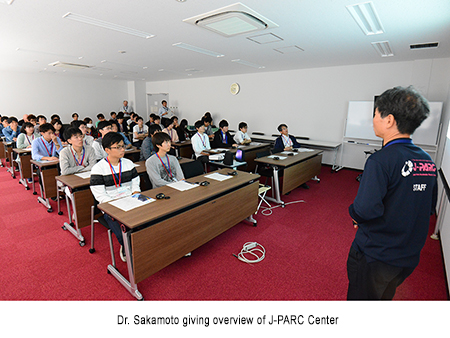
 * Click here to enlarge. * Click here to enlarge. |
| |
| £to Page Top |
| |
|
| The 5th J-PARC Hello Science "Reduce Wastes from Nuclear Power Plant with the use of Accelerator - Partitioning and Transmutation Technology for Spent Nuclear Fuel- " (May 26, Tokai Industry and Information Plaza "iVill") |
|---|
| The 5th Science Cafe, a part of "Hello Science" aimed to communicate with local citizens, was held and Toshinobu Sasa, leader of the Target Technology Development Section, gave a lecture on reducing spent nuclear fuel waste by Partitioning and Transmutation Technology. The Japan Atomic Energy Agency is researching "Partitioning Technology" to partition wastes according to their degree of harmfulness and "Nuclear Transmutation Technology" to treat partitioned wastes, while studies focused on the nuclear transmutation technology are conducted at J-PARC. Dr. Sasa explained that how partitioning and transmutation technology study on radioactive waste is important, comparing it to separated garbage disposal. He also introduced a waste treatment system utilizing an accelerator (ADS: Accelerator-driven System) which is being developed for practical use in 30 years. Many participants from adult to children showed their high degree of interest in this event. |
| |
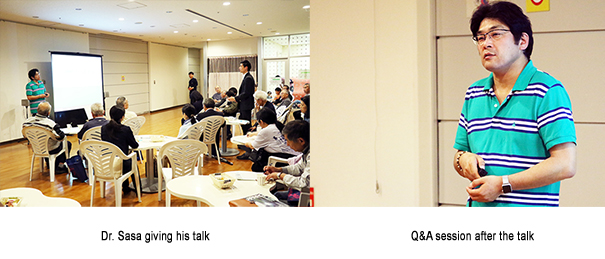
 * Click here to enlarge. * Click here to enlarge. |
| |
| £to Page Top |
| |
|
| J-PARC Hello Science Experimental Session at Nakamaru Elementary School (June 21, Tokai village) |
|---|
| J-PARC's PR section had planned and held Hello Science Experimental Session at the Science club of Tokai village Nakamaru Elementary School. This experimental session has been targeted for elementary school students in Tokai village. Nakamaru Elementary School became the third school to hold this session since it was started two years ago. Tatsuya Uzumaki from the PR section made a lecture and conducted an experiment and craft with a theme "light" on that day. In the experiment light, when liquid was exposed to black light (ultra violet light), containing vitamins that glowed in response to light, students squealed in admiration, observing the glowing drink. In making a kaleidoscope session, they made holes to make their own design on a diffraction grating sheet by using needles. Through observation of differences between fluorescent light and natural light, they realized that light consists of various kinds of colors. |
| |
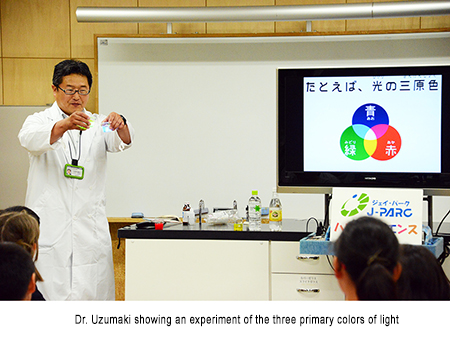
 * Click here to enlarge. * Click here to enlarge. |
| |
| £to Page Top |
| |
|
| The 14th Muon g-2/EDM Collaboration Meeting (June 7-9, J-PARC Research building, etc.) |
|---|
| The 14th Muon g-2/EDM Collaboration Meeting was held with 51 participants from Japan, Korea, Canada, and other nations. This meeting aims to offer world scientists the ability to gather and promote research on the precise measurement of g-2/EDM (anomalous magnetic moment/ electric dipole moment) using the ultra-cold Muon beam, planning to be experimented on Muon H line which is under preparation at MLF. In this meeting, the current situation regarding preparation for scheduled experiments, construction status of H line, and related U line preparation and operation were reported by concerned parties. There were also active discussions concerning resolution of issues toward the future. |
| |
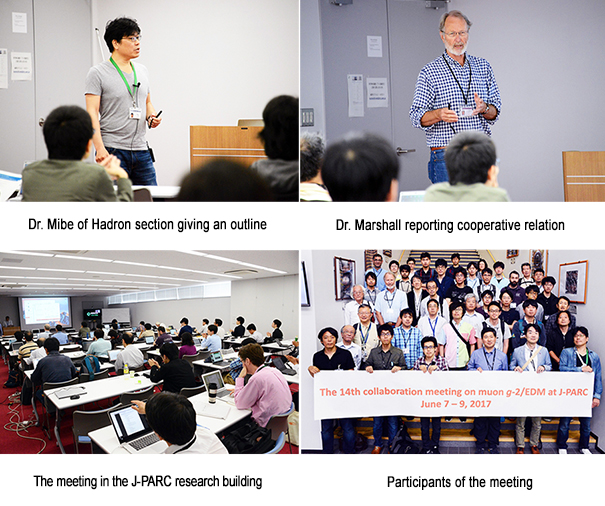
 * Click here to enlarge. * Click here to enlarge. |
| |
| £to Page Top |
| |
|
©2017 J-PARC Center. All rights reserved.
|
|